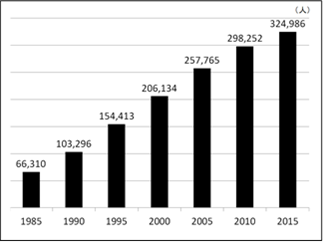Column Finance and the Social Security System 2018.01.19
【Aging, safety net and fiscal crisis in Japan】No.9: Medical Expenses for Dialysis
According to data published by the Japanese Society for Dialysis Therapy, there were 324,986 dialysis patients in Japan at the end of December 2015. As shown in Figure 1, this is approximately five times greater than 30 years ago. Japan has a high number of dialysis patients compared with other countries. For example, whereas the number of dialysis patients per million people in the United States is 1,450 (source: National Institute of Health), it reached 2,557 in Japan. This is partially due to the low number of kidney transplants in Japan (141 in 2016).
Due to technical improvements in artificial dialysis, the lifespan of dialysis patients has been prolonged. Among the 324,986 patients in 2015, 51,716 were 80 to 89 years old and 5,560 were over 90 years old. In addition, 6,630 patients had received dialysis for more than 30 years.
On the other hand, the medical expenses for renal failure in FY 2015 are 1,564 billion yen (14 billion US dollars: 110 yen = 1US$). The number of dialysis facilities is 4,321, most of which are for-profit private healthcare organizations. Because the annual medical expenses per person are as high as 4.81 million yen ($43,700 US), dialysis facilities' profit margins are higher than those of other healthcare departments. Consequently, it is necessary to put a "scalpel" in the vested interests of these dialysis facilities to protect the public insurance system in fiscal crisis.

